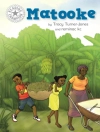‘The list of math books to truly synthesize what we know so far and what we need to know is a very short and exclusive list. Well, you can confidently add Mathematize It to this collection. Written by three of the most respected math educators today, the book zeros in on that often poorly traveled journey between the question and answer in problem solving. Mathematize It will be your go-to resource to install the mathematical play revolution in elementary classes everywhere!’
Suni Singh
Author of Pi of Life: the Hidden Happiness of Mathematics and Math Recess: Playful Learning in an Age of Disruption
Help students reveal the math behind the words
‘I don’t get what I’m supposed to do!’ This is a common refrain from students when asked to solve word problems.
Solving problems is about more than computation. Students must understand the mathematics of a situation to know what computation will lead to an appropriate solution. Many students often pluck numbers from the problem and plug them into an equation using the first operation they can think of (or the last one they practiced). Students also tend to choose an operation by solely relying on key words that they believe will help them arrive at an answer, which without careful consideration of what the problem is actually asking of them.
Mathematize It! Going Beyond Key Words to Make Sense of Word Problems, Grades 3-5 shares a reasoning approach that helps students dig into the problem to uncover the underlying mathematics, deeply consider the problem’s context, and employ strong operation sense to solve it. Through the process of mathematizing, the authors provide an explanation of a consistent method—and specific instructional strategies—to take the initial focus off specific numbers and computations and put it on the actions and relationships expressed in the problem.
Sure to enhance teachers’ own operation sense, this user-friendly resource for Grades 3–5
• Offers a systematic mathematizing process for students to use when solving word problems • Gives practice opportunities and dozens of problems to leverage in the classroom • Provides specific examples of questions and explorations for all four operations (addition, subtraction, multiplication, and division) with whole numbers, fractions, and decimals • Demonstrates the use of concrete manipulatives to model problems with dozens of short videos • Includes end-of-chapter activities and reflection questions How can you help your students understand what is happening mathematically when solving word problems? Mathematize it!
Table of Content
Video List
Preface
Chapter 1 Introduction: Why You Need to Teach Students to Mathematize
Problem Solving Strategies Gone Wrong
What is Mathematizing? Why Is It Important?
Teaching Students to Mathematize
Final Words Before You Dive In
Part 1 Addition and Subtraction
Chapter 2: Add-To and Take-From: Locating the Change
Thinking About Active Addition and Subtraction Situations
Moving Beyond Whole Numbers
Key Ideas
Try It Out!
Reflect
Chapter 3: Part-Part-Whole: Understanding the Relationship
Thinking About Part-Part-Whole Situations
Moving Beyond Whole Numbers
Key Ideas
Try It Out!
Reflect
Chapter 4: Additive Comparisons: Another Kind of Relationship
Thinking About Additive Comparison Situations
Moving Beyond Whole Numbers
Key Ideas
Try It Out!
Reflect
Part 2: Multiplication and Division
Chapter 5: Equal Groups Multiplication: Two Factors, Different Jobs
Thinking About Equal Groups Situations
Moving Beyond Whole Numbers
Key Ideas
Try it Out!
Reflect
Chapter 6: Equal Groups Division: When a Factor Is Missing
Thinking About Equal Groups Division
Moving Beyond Whole Numbers
Key Ideas
Try it Out!
Reflect
Chapter 7: Multiplicative Comparisons: Another Asymmetric Relationship
Thinking About Multiplicative Comparisons
Moving Beyond Whole Numbers
Key Ideas
Try It Out!
Reflect
Chapter 8: Area and Array: Two Factors, Same Job
Thinking About Area and Array Situations
Moving Beyond Whole Numbers
Key Ideas
Try It Out!
Reflect
Chapter 9: Changing How You Teach Word Problems
Getting into the Mathematizing Sandbox
8 Shifts in Instruction for Building Students’ Problem-Solving Skills
Guidance for Moving Forward: FAQ’s
Appendix A – Situation Tables
References
Index
About the author
Winner of the Presidential Award for Excellence in Science and Mathematics Teaching, Linda M. Gojak directed the Center for Mathematics and Science Education, Teaching, and Technology (CMSETT) at John Carroll University for 16 years. She has spent 28 years teaching elementary and middle school mathematics, and has served as the president of the National Council of Teachers of Mathematics (NCTM), the National Council of Supervisors of Mathematics (NCSM), and the Ohio Council of Teachers of Mathematics.
![Kimberly Morrow-Leong & Sara Delano Delano Moore: Mathematize It! [Grades 3-5] (ePUB) Cover of Kimberly Morrow-Leong & Sara Delano Delano Moore: Mathematize It! [Grades 3-5] (ePUB)](https://static.worldofdigitals.com/info_webp/258/9781506395258.webp)











